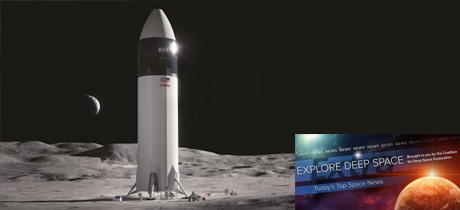In Today’s Deep Space Extra… Legislative supporters back more money for NASA in an infrastructure bill. A new study contends that the Martian crust could sustain life through radiation.
Human Space Exploration
NASA’s hopes for infrastructure funding grow to $15.7 billion
Spacepolicyonline.com (8/15): Democratic senators from Virginia and California are pressing to increase NASA’s share of an infrastructure bill from $11.5 billion to $15.7 billion. The requested funds are intended to help with development of a second lunar Human Landing System (HLS), address infrastructure needs, and other necessities that may include space suit and nuclear propulsion development and that are not included in the agency’s 2022 budget request. The request is included in a letter addressed to Senate Majority Leader Chuck Schumer and Senate Budget Committee Chair Bernie Sanders. Much remains to unfold before it will be possible to determine whether NASA becomes a recipient and for what purposes.
GAO report details rejection of HLS protests
SpaceNews.com (8/16): The Government Accountability Office (GAO) offered more details about its decision to reject protests filed by Blue Origin and Dynetics of NASA’s Human Landing System (HLS) award. The GAO announced its decision July 30 but withheld the formal memo until a version suitable for public release was available. The office rejected claims by the protesting companies that NASA erred by making a single award; it also rejected claims that their proposals were unfairly evaluated in comparison with SpaceX’s. The GAO did agree with one claim that the protestors made about how NASA evaluated SpaceX’s proposal. SpaceX’s concept of operations for its Starship lunar lander requires 16 launches: one of the lander itself, 14 “tanker” Starships to fuel it, and another whose purpose is redacted. The protestors argued that NASA erred in not requiring a flight readiness review (FRR) for each launch. However, the GAO also concluded that this oversight did not have a material impact on the competition.
Russian space officials try to blame NASA astronaut for Soyuz air leak in 2018: report
Coalition Member in the News – Boeing
Space.com (8/14): NASA’s Kathy Lueders, the agency’s associate administrator for human exploration and operations, rebuffed comments attributed to Russian Space Agency leadership that a NASA astronaut was responsible for a small leak in a Russian Soyuz crew capsule docked to the International Space Station (ISS) during a 2018 mission. “I did not find this accusation credible,” Lueders commented during a news briefing regarding the launch of the Boeing Orbital Flight Test-2 (OFT-2). Nelson offered his support through social media.
Starliner test flight faces months-long delay
Coalition Members in the News – Boeing, Aerojet Rocketdyne, United Launch Alliance
SpaceNews.com (8/13): Boeing and NASA’s Commercial Crew Program have delayed plans for the Orbital Flight Test-2 (OFT-2) launch of the company’s CST-100 Starliner in order to pin down the cause of propulsion system valve motion restrictions encountered as they prepared to launch the uncrewed mission to the International Space Station (ISS) on August 4.
Space Science
Martian crust could sustain life through radiation
Space.com (8/15): Deep below the ground, radioactive elements disintegrate water molecules, producing ingredients that can fuel subterranean life. This process, known as radiolysis, has sustained bacteria in water-filled cracks and rock pores on Earth for millions of years. Now a study contends that radiolysis could have powered microbial life in the Martian subsurface. The study, published in the journal Astrobiology, was led by a NASA Jet Propulsion Laboratory (JPL) scientist.
Other News
Federal Trade Commission chair appears skeptical of proposed Lockheed-Aerojet merger
Coalition Members in the News – Aerojet Rocketdyne, Lockheed Martin, Northrop Grumman
SpaceNews.com (8/15): Lockheed Martin has proposed the $4.4 billion acquisition of Aerojet Rocketdyne, the rocket engine manufacturer. However, the transaction is “under a cloud of uncertainty,” according to a news report, after FTC chair Lina Khan expressed concerns about vertical mergers where a large corporation seeks to acquire a major supplier. Khan’s concerns made their way to U.S. Sen. Elizabeth Warren, who has been a longtime critic of defense industry consolidation.
From Apollo to multi-user, the changing yet similar nature of Launch Complex 39
Coalition Members in the News – Boeing, Northrop Grumman
NASAspaceflight.com (8/15): From its inception at NASA’s Kennedy Space Center (KSC) in support of the Apollo program during the 1960s to the present, Launch Complex 39 B’s role in supporting the exploration of space has and continues to adapt and evolve.
End of an era: Space and Missile Systems Center is now Space Systems Command
SpaceNews.com (8/13): On Friday, the U.S. Space Force officially renamed the Space and Missile Systems Center, based at the Los Angeles Air Force Base in El Segundo, California, as the Space Systems Command. The new command is to oversee the development of advanced technologies, launch services, and satellite procurements.
Major Space Related Activities for the Week
Major space related activities for August 15 to 28, 2021
Spacepolicyonline.com (8/15): In Washington, while the U.S. House will be in session again next week, the Senate will not until September 13, except for proforma activities. The 2022 fiscal year budget, the infrastructure bill, as well as a human infrastructure bill, each potentially emerging with provisions impacting NASA’s future, remain in play. The ISS Research and Development Conference is hosting technical sessions on Monday through Wednesday. The Lunar Surface Science Workshop on Fundamental and Applied Lunar Surface Research in Physical Sciences gathers Wednesday and Thursday. The annual Space Symposium convenes virtually and in person in Colorado Springs, Colorado, August 23-26. Featured speakers include NASA Administrator Bill Nelson, European Space Agency (ESA) Director General Josef Aschbacher and Chirag Parikh, the newly appointed executive secretary of the National Space Council.

